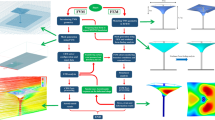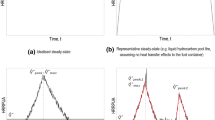Abstract
The quantification of thermal action is important to the analysis of structural-fire performance of bridges. This study evaluates the parameters for the localized fire model adopted in SFPE Handbook for application to the fire scenario of a tanker truck burning beneath a bridge. Modification is applied first to the flame length and then to the distribution of gauge heat flux using the simulation results of various fire models established in Fire Dynamics Simulator considering parameters, including the sectional dimensions of bridge, bridge headroom, truck size and heat release rate. Spatially varied gauge heat flux or adiabatic surface temperature of the bridge can be predicted with this fire model. Implementation of this modified fire model in structural-fire analysis is illustrated with a sequentially coupled thermo-mechanical modelling of a post-tensioned segmental concrete box girder bridge exposed to tanker truck fire. The adiabatic surface temperature calculated from the modified fire model is applied as thermal boundary to the bridge. Simulation results show that, although the global structural responses are seldom influenced by fire, localized damage in concrete and tendon may result. The prestress in tendons near mid-span may be reduced even after the bridge is cooled down to ambient temperature, which may adversely affect its load-carrying capacity. The damage to concrete may also induce localized separation between adjacent segments, possibly affecting the durability of tendons.




















Similar content being viewed by others
References
Federal Highway Administration (FHWA) (2016) Post-tensioned box girder design manual. FHWA, Washington, DC
Giuliani L, Crosti C, Gentili F (2012) Vulnerability of bridges to fire. In: Proceedings, 6th international conference on bridge maintenance, safety and management, Abingdon, pp 8–12
Garlock MEM, Paya-Zaforteza I, Kodur VKR, Gu L (2012) Fire hazard in bridges: review, assessment and repair strategies. Eng Struct 35:89–98. https://doi.org/10.1016/j.engstruct.2011.11.002
Garlock MEM, Gu L, Kodur VK (2010) Review and assessment of fire hazard in bridges. J Transp Res Board 2172(1):23–29. https://doi.org/10.3141/2172-03
American Association of State Highway and Transportation Officials (AASHTO) (2002) Standard specifications for highway bridges. AASHTO, Washington, DC
Mendes PA, Valente JC, and Branco FA (2000) Simulation of ship fire under vasco da gama bridge. ACI Struct J 97(2):285–290
Alnahhal WI, Chiewanichakorn M, Aref AJ, Alampalli S (2006) Temporal thermal behavior and damage simulations of FRP deck. J Bridge Eng 11(4):452–464. https://doi.org/10.1061//asce/1084-0702/2006/11:4/452
Bennetts I, Moinuddin K (2009) Evaluation of the impact of potential fire scenarios on structural elements of a cable-stayed bridge. J Fire Prot Eng 19 (2):85–106. https://doi.org/10.1177/1042391508095091
European committee for standardization (CEN) (2002) Eurocode 1: EN 1991-1-2: actions on structures. Part 1–2: general Actions-Actions on structures exposed to fire. CEN, Brussels
Heskestad G (2016) SFPE handbook of fire protection engineering, vol 13. Fire plumes, flame height, and air entrainment, 5th edn. National Fire Protection Association, Greenbelt, MD
Zhang C, Li G (2012) Fire dynamic simulation on thermal actions in localized fires in large enclosure. Adv Steel Constr 8:124–136
Zhang C, Choe L, Seif M, Zhang Z (2015) Behavior of axially loaded steel short columns subjected to a localized fire. J Constr Steel Res 111:103–111. https://doi.org/10.1016/j.jcsr.2014.11.012
Lattimer BY (2016) SFPE handbook of fire protection engineering, vol 25. Heat fluxes from fires to surfaces, 5th edn. National Fire Protection Association, Greenbelt, MD
Zhang C, Gross JL, McAllister TP, Li GQ (2015) Behavior of unrestrained and restrained bare steel columns subjected to localized fire. J Struct Eng. https://doi.org/10.1061/(asce)st.1943-541x.0001225
Jiang L, Chen S, Usmani A (2018) Feasibility of dimensionally reduced heat transfer analysis for structural members subjected to localised fire. Adv Struct Eng 21(11):1708–1722. https://doi.org/10.1177/1369433218754334
Hasemi Y, Yokobayashi S, Wakamatsu T, Ptchelintsev A (1995) Fire safety of building components exposed to a localized fire: scope and experiments on ceiling/beam system exposed to a localized fire. In: Proceedings, ASIAFLAM, Kowloon, Hong Kong
Wakamatsu T, Hasemi Y, Yokobayashi S, Ptchelintsev A (1996) Experimental study on the heating mechanism of a steel beam exposed to a localized fire. In: Proceedings, INTERFLAM, Cambridge
Pchelintsev A, Hasemi Y, Wakamatsu T, Yokobayashi Y (1997) Experimental and numerical study on the behaviour of a steel beam under ceiling exposed to a localized fire. Fire Saf Sci 5:1153–1164
Myllymaki J, Kokkala M (2000) Thermal exposure to a high welded I-beam above a pool fire. In: First intenational workshop on structures in fires, Copenhagen, Denmark, pp 211–226
Choi J, Haj-Ali R, Kim HS (2012) Integrated fire dynamic and thermomechanical modeling of a bridge under fire. Struct Eng Mech 42(6):815–829
Alos-Moya J, Paya-Zaforteza I, Garlock MEM, Loma-Ossorio E, Schiffner D, Hospitaler A (2014) Analysis of a bridge failure due to fire using computational fluid dynamics and finite element models. Eng Struct 68:96–110. https://doi.org/10.1016/j.engstruct.2014.02.022
Peris-Sayol G, Paya-Zaforteza I, Alos-Moya J, Hospitaler A (2015) Analysis of the influence of geometric, modeling and environmental parameters on the fire response of steel bridges subjected to realistic fire scenarios. Comput Struct 158:333–345. https://doi.org/10.1016/j.compstruc.2015.06.003
Peris-Sayol G, Paya-Zaforteza I, Balasch-Parisi S, Alós-Moya J (2017) Detailed analysis of the causes of bridge fires and their associated damage levels. J Perform Constr Fac. https://doi.org/10.1061/(asce)cf.1943-5509.0000977
Gong X, Agrawal AK (2014) Numerical simulation of fire damage to a long-span truss bridge. J Bridge Eng. https://doi.org/10.1061/(asce)be.1943-5592.0000707
McGrattan K, Hostikka S, McDermott R, Floyd J, Weinschenk C, Overholt K (2014) Fire dynamics simulator, user’s guide, 6th edn. NIST, Gaithersburg
McGrattan K, Hostikka S, McDermott R, Floyd J, Weinschenk C, Overholt K (2014) Fire dynamics simulator, technical reference guide, 6th edn, vol 2: verification. NIST, Gaithersburg
McGrattan K, Hostikka S, McDermott R, Floyd J, Weinschenk C, Overholt K (2014) Fire dynamics simulator, technical reference guide, 6th edn, vol 3: validation. NIST, Gaithersburg
SIMULIA (2014). Analysis user’s manual. Dassault Systèmes, Providence
Prestressed Concrete Institute (PCI) (1978) Precast segmental box girder bridge manual, vol 5. PCI, Chicago
Wu XQ, Au FTK (2017) Numerical simulation of prestressed concrete bridges exposed to potential bushfire. In: 2nd International fire safety symposium, Naples, Italy
Zhang C, Li GQ (2012) Fire dynamic simulation on thermal actions in localized fires in large enclosure. Adv Steel Constr 8(2):124–136. https://doi.org/10.18057/ijasc.2012.8.2.2
Lin CH, Ferng YM, Hsu WS (2009) Investigating the effect of computational grid sizes on the predicted characteristics of thermal radiation for a fire. Appl Therm Eng 29(11–12):2243–2250. https://doi.org/10.1016/j.applthermaleng.2008.11.010
European committee for standardization (CEN) (2004) Eurocode 2: EN 1992-1-2: design of concrete structures. Part 1–2: general rules-Structural fire design. CEN, Brussels
Malalasekera W, Versteeg HK, Gilchrist K (1996) A review of research and an experimental study on the pulsation of buoyant diffusion flames and pool fires. Fire Mater 20(6):261–271
Sudheer S, Saumil D, Prabhu SV (2013) Physical experiments and fire dynamics simulator simulations on gasoline pool fires. J Fire Sci 31 (4):309–329. https://doi.org/10.1177/0734904112472953
Heskestad G (1983) Luminous heights of turbulent diffusion flames. Fire Saf J 5(2):103–108
Lin CH, Ferng YM, Hsu WS, Pei BS (2008) Investigations on the characteristics of radiative heat transfer in liquid pool fires. Fire Technol 46 (2):321–345. https://doi.org/10.1007/s10694-008-0071-7
Forney GP (2014) Smokeview, a tool for visualizing fire dynamics simulation data, 6th edn. NIST, Gaithersburg
Hasemi Y, Nishihata M (1989) Fuel shape effect on the deterministic properties of turbulent diffusion flames. Bull. Jpn Assoc Fire Sci Eng 38(2):29–34
Wickström U, Duthinh D, McGrattan KB (2007) Adiabatic surface temperature for calculating heat transfer to fire exposed structures. In: Proceedings, 11th international interflam conference, London
European committee for standardization (CEN) (2005) Eurocode 4: EN 1994-1-2: design of composite steel and concrete structures. Part 1–2: general rules-Structural fire design. CEN, Brussels
Hertz KD (2004) Reinforcement data for fire safety design. Mag Concrete Res 56 (8):453–459
Zhang L, Wei Y, Au FTK, Li J (2017) Mechanical properties of prestressing steel in and after fire. Mag Concrete Res 69(8):379–388. https://doi.org/10.1680/jmacr.15.00267
FIB (2012) Model code for concrete structures 2010. Ernst & Sohn, Berlin
Khalaf J, Huang ZH (2016) Analysis of the bond behaviour between prestressed strands and concrete in fire. Constr Build Mater 128:12–23. https://doi.org/10.1016/j.conbuildmat.2016.10.016
Ali HM, Senseny PE, Alpert RL (2004) Lateral displacement and collapse of single-story steel frames in uncontrolled fires. Eng Struct 26(5):593–607. https://doi.org/10.1016/j.engstruct.2003.12.007
European committee for standardization (CEN) (2005) Eurocode 2: EN 1992-2: design of concrete structures. Part 2: concrete bridges-Design and detailing rules. CEN, Brussels
Author information
Authors and Affiliations
Corresponding author
Additional information
Publisher's Note
Springer Nature remains neutral with regard to jurisdictional claims in published maps and institutional affiliations.
Rights and permissions
About this article
Cite this article
Wu, Xq., Huang, T., Au, F.T.K. et al. A Localized Fire Model for Predicting the Surface Temperature of Box Girder Bridges Subjected to Tanker Truck Fire. Fire Technol 56, 2059–2087 (2020). https://doi.org/10.1007/s10694-020-00966-2
Received:
Accepted:
Published:
Issue Date:
DOI: https://doi.org/10.1007/s10694-020-00966-2




